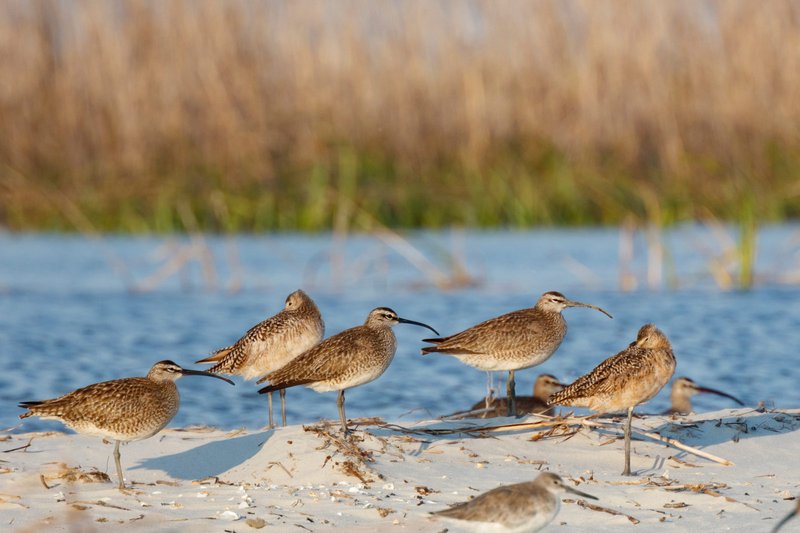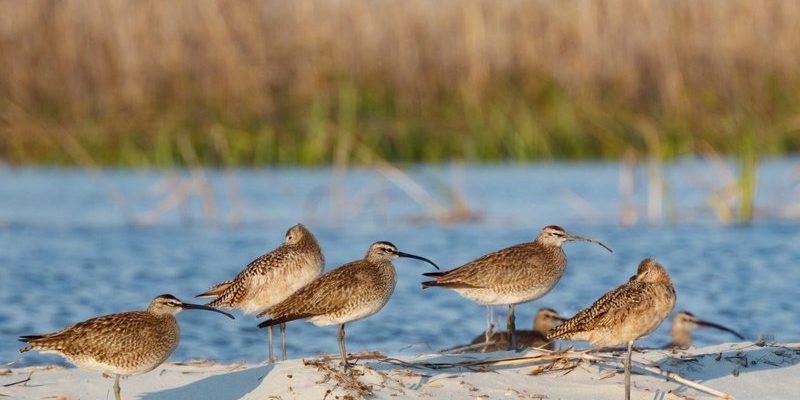
Imagine a bird that epitomizes the spirit of the shore—a lively character, darting across beaches and marshlands with a distinctive elegance. That’s the Whimbrel for you! This medium-sized shorebird belongs to the curlew family and stands out not just for its physical appearance but also for its captivating behavior.
With its long, curved bill and striking plumage, the Whimbrel is a true wanderer of the coastline. They are often spotted in groups, foraging along the water’s edge and showcasing their graceful movements. These birds are known for their incredible migratory patterns, traveling vast distances between their breeding and wintering grounds. It’s a remarkable journey that truly underlines their resilience and adaptability.
In this article, we’ll dive deeper into everything you need to know about Whimbrels—their physical characteristics, habitat, diet, behavior, and more. Whether you’re a birdwatcher or just curious about wildlife, there’s plenty to discover about this intriguing shorebird!
Physical Characteristics of Whimbrels
Whimbrels are striking birds, easily recognizable due to their unique features. Typically measuring around 14 to 16 inches in length, they boast a wingspan of about 29 to 33 inches. Their plumage is a beautiful blend of brown, gray, and white, which provides excellent camouflage against their natural habitats.
One of the most remarkable aspects of the Whimbrel’s appearance is its long, downward-curved bill. This bill can measure around 4 to 7 inches, which they use skillfully to probe mud and sand for insects, worms, and crustaceans. When they are foraging, the Whimbrel’s keen eyesight and exceptional hunting skills come into play. You might even notice them using their bill to dig and flip small stones in search of hidden treats.
Another notable characteristic is their distinctive facial markings. The Whimbrel has a bold, dark stripe that runs from its bill through the eye and extends to the nape of its neck. This striking pattern not only adds to their beauty but also makes them stand out among other shorebirds. If you ever have the chance to observe one up close, you’ll appreciate just how fascinating these birds truly are!
Habitat and Range
Whimbrels are found in a variety of habitats, predominantly along coastal regions, estuaries, and wetlands. During the breeding season, they typically prefer the tundra, where they can establish nests in low vegetation. This choice of habitat is crucial, as it provides them with the necessary cover and safety from predators.
Your journey to spotting a Whimbrel might take you to sandy shores, mudflats, or even grassy marshes. They are often seen foraging for food during low tide, so visiting coastal areas at these times can increase your chances of encountering them. Because of their migratory nature, their range expands and contracts with the seasons, spanning from the Arctic regions during breeding to southern coasts in the winter.
In North America, Whimbrels can be spotted along the Atlantic coast, especially during migration. They also inhabit parts of the Pacific coast. Furthermore, these beautiful birds are found in various parts of Europe and Asia, showcasing their wide-ranging adaptability. Whether they are in their breeding or wintering grounds, Whimbrels continue to impress with their ability to thrive in diverse environments.
Diet and Feeding Behavior
When it comes to food, Whimbrels are opportunistic feeders. Their diet primarily consists of invertebrates, including worms, crustaceans, and small mollusks. They are particularly skilled at hunting for food, using their long bills to probe deep into the sand or mud. This behavior is crucial for their survival, as they need to find enough nourishment to sustain their long migratory journeys.
You might wonder how a Whimbrel knows where to find food. These birds have an excellent sense of sight and can spot movements in the sand. When they find a potential meal, they use their bill to dig or flip over the substrate, unearthing their prize. This characteristic not only showcases their feeding proficiency but also their adaptability to various environments.
Interestingly, Whimbrels also exhibit a behavior known as “habitat selection.” They often choose feeding areas based on the availability of food and safety from predators. During low tide, they can forage more effectively, taking advantage of the exposed sandy areas to hunt for their meals. This strategic approach to feeding is one of the reasons why Whimbrels are so successful in their habitats.
Migration Patterns
Whimbrels are renowned for their extensive migratory patterns, which can span thousands of miles. These birds migrate from their breeding grounds in the Arctic tundra to wintering areas in coastal regions of Central and South America. This journey can be a hefty challenge, as they face various environmental factors and potential predators along the way.
The migration typically occurs twice a year—their northward journey in spring and their southward return in fall. During these times, you might see them flying in large flocks, gracefully gliding through the air. Their flights can cover significant distances, and they often follow specific routes that provide them with landmarks and safe resting spots along the way.
To prepare for migration, Whimbrels fatten up, storing energy reserves that will sustain them during their long flights. Their remarkable navigational skills, combined with their ability to sense seasonal changes, help them time their journeys precisely. For birdwatchers and enthusiasts, witnessing a flock of Whimbrels during migration is truly a magnificent sight!
Reproduction and Nesting
When it comes to raising their young, Whimbrels are dedicated parents. The breeding season usually starts in late spring when they migrate back to their Arctic nesting grounds. This is an exciting time, as males perform elaborate displays to attract females, showcasing their vibrant personalities.
The actual nesting process is quite unique. Whimbrels typically create their nests on the ground, often in areas hidden among low vegetation. These nests are simple and consist of small depressions lined with grass and feathers. Once the female lays her eggs—typically four in a clutch—both parents take turns incubating them, ensuring they remain safe and warm.
After about 27 to 30 days, the eggs hatch, and the chicks are precocial, meaning they are relatively mature and can leave the nest shortly after hatching. This is essential for survival, as they must quickly learn to forage for food and avoid predators. Parental care doesn’t end there; both parents continue to protect and guide their young until they are ready to migrate themselves. This commitment to their offspring reflects the nurturing nature of these wonderful birds.
| Characteristic | Details |
|---|---|
| Size: | 14 to 16 inches long |
| Wingspan: | 29 to 33 inches |
| Weight: | 7 to 14 ounces |
| Habitat: | Coastal areas, estuaries, tundra |
| Diet: | Invertebrates, worms, crustaceans |
| Migratory Range: | Arctic tundra to Central/South America |
| Lifespan: | Up to 10 years in the wild |
Conservation Status
Like many bird species, Whimbrels face threats that impact their populations. Habitat loss, climate change, and pollution are significant concerns for these shorebirds. As coastal areas are developed and altered, the natural habitats that Whimbrels rely on for nesting and feeding become increasingly limited.
Conservation efforts are crucial to ensuring the survival of Whimbrels. Organizations and researchers work tirelessly to monitor their populations and habitats. Protecting coastal areas and wetlands is vital, as these regions provide essential resources and shelter for many bird species, including the Whimbrel.
Community awareness is also key in conservation efforts. Engaging with local communities and educating them about the importance of preserving natural habitats can make a significant difference. By advocating for sustainable practices and supporting wildlife organizations, we can all contribute to the well-being of Whimbrels and other wildlife.
Where to Spot Whimbrels
If you’re keen on seeing Whimbrels in their natural habitat, coastal regions are your best bet. Here are a few spots where you might catch a glimpse of these elegant birds:
- Estuaries: These areas are teeming with food sources, making them ideal feeding grounds for Whimbrels.
- Sandy Beaches: Look for them along the shore during low tide when they forage for food.
- Wetlands: Marshy areas provide excellent nesting sites and feeding opportunities.
It’s best to visit these locations early in the morning or late in the afternoon, as these are peak feeding times. Don’t forget your binoculars! Observing Whimbrels in action can be a rewarding experience, especially when you see their graceful movements and unique feeding behaviors.
Fun Facts About Whimbrels
There’s no shortage of fascinating tidbits about Whimbrels that make them even more interesting:
- Whimbrels are known for their distinctive call, which sounds a bit like a series of rhythmic “whimbrel” notes. It’s a sound that reflects their name!
- These birds are incredibly social, often seen foraging in groups, providing a beautiful display of camaraderie.
- Whimbrels can migrate up to 6,000 miles, showcasing their incredible endurance and navigational skills.
These fun facts not only highlight their individuality but also remind us of the wonders of wildlife and the rich tapestry of life that surrounds us.
FAQ
What do Whimbrels look like?
Whimbrels are medium-sized shorebirds that feature long, curved bills and striking plumage. Their feathers are a mix of brown and gray, providing excellent camouflage while foraging. Their head is adorned with a distinctive dark stripe that runs from the bill through the eye, making them quite recognizable.
Are Whimbrels migratory birds?
Yes, Whimbrels are highly migratory. They breed in the Arctic tundra and migrate to warmer coastal regions in Central and South America during winter. Their migrations can cover impressive distances, sometimes exceeding 6,000 miles!
What do Whimbrels eat?
Whimbrels primarily feed on invertebrates like worms, crustaceans, and small mollusks. They use their long bills to probe into the sand and mud, searching for hidden food sources. Their feeding behavior is quite fascinating to observe.
How does the Whimbrel adapt to its environment?
Whimbrels are remarkably adaptable. They can thrive in various habitats, including coastal areas, estuaries, and wetlands. Their long bills allow them to forage effectively, and their migratory patterns help them exploit abundant food resources across different regions throughout the year.
Where can I see Whimbrels?
You can spot Whimbrels along sandy beaches, estuaries, and wetlands, particularly during low tide when they come out to forage. Coastal regions of North America, Europe, and parts of Asia are great places to look for these elegant birds.
What threats do Whimbrels face?
Whimbrels face several threats, including habitat loss due to coastal development, climate change, and pollution. Conservation efforts are crucial for their survival and aim to protect the habitats they rely on for nesting and feeding.
How long do Whimbrels live?
Whimbrels can live up to 10 years in the wild. Their life expectancy can vary based on environmental conditions and threats they face in their habitats.
Do Whimbrels form monogamous pairs?
Whimbrels do tend to form monogamous pairs during the breeding season. The male will perform displays to attract a mate, and both parents share the responsibilities of incubating the eggs and caring for the chicks.
What is the significance of the Whimbrel’s call?
The call of the Whimbrel is a distinctive series of rhythmic notes that can be heard during migration and breeding. It’s used for communication between mates and flocks and plays an essential role in their social behavior.
Are Whimbrels endangered?
While Whimbrels are not currently classified as endangered, their populations are declining due to habitat loss and other environmental threats. Conservation measures are essential to maintain healthy populations and protect their habitats.
Can Whimbrels be found inland?
While Whimbrels are primarily coastal birds, they may occasionally be found inland in areas with suitable wetland habitats. However, they are most commonly associated with shorelines and estuarine environments.
What makes Whimbrels unique among shorebirds?
Whimbrels are unique due to their long, curved bills and striking calls. Their migratory patterns, social behaviors, and adaptability to different habitats also set them apart from other shorebirds, making them a favorite among birdwatchers and nature enthusiasts alike.

